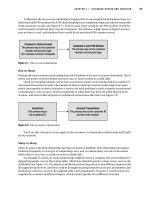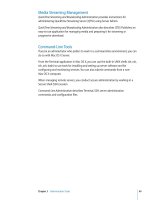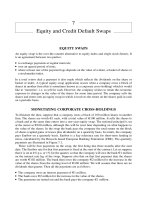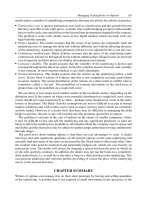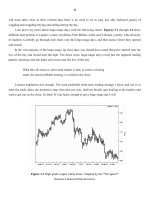STUDY GUIDE FOR COME INTO MY TRADING ROOM phần 3 pot
Bạn đang xem bản rút gọn của tài liệu. Xem và tải ngay bản đầy đủ của tài liệu tại đây (293.23 KB, 20 trang )
Question 31—Grading Trades
Envelopes or channels can help you grade your performance as a trader.
What are the grades for the following trades:
1. Trader A buys a stock at 56, above the rising EMA, and sells at 59.
The upper line is at 60.5, the lower at 49.5.
2. Trader B buys a stock 17.5, near the rising EMA, and sells at 18.5.
The upper channel line is at 20, the lower at 13.
3. Trader C buys a stock in a trading range at 21, but it sinks and he
bails out on a stop at 19. The upper line is at 24, the lower at 16.
4. Trader D sells short a stock at 88, near a falling moving average, and
covers at 81. The upper line is at 99, the lower at 81.
Question 32—MACD
Match the following phrases about MACD:
1. Long-term consensus of value
2. MACD-Histogram
3. Short-term consensus of value
4. Lower peak of MACD-Histogram while prices reach a higher peak
5. Higher bottom of MACD-Histogram while prices sink to a lower low
A. Fast line of MACD
B. Bullish divergence
C. Bearish divergence
D. Slow line of MACD
E. The spread between MACD-lines
INDICATORS—FIVE BULLETS TO A CLIP 33
Question 33—MACD
34 QUESTIONS
AB C D EF
Figure 4.3
Match the following signals of MACD-Histogram with the letters in
Figure 4.3:
1. Uptrend
2. Downtrend
3. Bullish divergence
4. Bearish divergence
5. Price tail
And for extra credit:
At the right edge of the chart, bullish, bearish, or neutral? Please explain.
Question 34—Force Index
Which of the following phrases does not apply to Force Index?
1. Measures price changes
2. Depends on the direction of prices
3. Should be smoothed with an EMA
4. Measures day-to-day volume changes
5. Spikes tend to mark reversal areas
Question 35—Force Index
INDICATORS—FIVE BULLETS TO A CLIP 35
ACBDEFG
H
Figure 4.4
Match the following signals of Force Index with the letters in Figure 4.4:
1. Buy signal
2. Sell signal
3. Bullish divergence
4. Spike
And for extra credit:
At the right edge of the chart, bullish, bearish, or neutral? Please explain.
Question 36—Elder-ray
Match the following statements about Elder-ray:
1. Bear Power becoming negative, then ticking up
2. The distance from the high of the bar to the EMA
3. The average consensus of value
4. The distance from the low of the bar to the EMA
5. Bull Power becoming positive, then ticking down
A. Moving average
B. Sell signal in a downtrend
C. Bear Power
D. Buy signal during an uptrend
E. Bull Power
36 QUESTIONS
Question 37—Elder-ray
INDICATORS—FIVE BULLETS TO A CLIP 37
AB CD E F
bull power
bear power
Figure 4.5
Match the following signals of Elder-ray with the letters in Figure 4.5:
1. Buy signal from Bear Power
2. Shorting signal from Bull Power
3. New peak of Bull Power—expect higher prices ahead
4. Bearish divergence of Bull Power
5. Price tail
And for extra credit:
At the right edge of the chart, bullish, bearish, or neutral? Please explain.
Match the following Stochastic signals with the letters in Figure 4.6:
1. Buy signal
2. Sell signal
3. Bullish divergence
4. Bearish divergence
And for extra credit:
At the right edge of the chart, bullish, bearish, or neutral? Please explain.
Question 38—Stochastic
Which of the following statements about Stochastic is incorrect?
1. It helps identify overbought and oversold conditions.
2. Look to sell when Stochastic is above its upper reference line.
3. Its divergences give the strongest signals.
4. It helps identify trends.
5. Avoid shorting when Stochastic is below its lower reference line.
Question 39—Stochastic
38 QUESTIONS
AB CD EF GHIJ KL
Figure 4.6
FIVE
TRADING
Beginning traders tend to stumble into several pitfalls. Many jump into
the markets without knowing enough about trading. Some make a few
dollars thanks to beginners’ luck, but practically all beginners end up
losing money. That’s when they hit the books—and more and more
books, afraid to pull the trigger, with lingering memories of the beating
they received. A beaten trader who concentrates on market analysis but
does not trade is suffering from “paralysis from analysis.”
An intelligent trader realizes that his or her knowledge of the market
can never be complete. The markets are huge, influenced by many fac-
tors, and have a fair bit of uncertainty. There is no such thing as perfect
understanding. Once the preponderance of signals from your indicators
points to a trade, it is time to calculate the risks, set stops, and put on
the trade, without waiting for a perfect signal, which is likely to come
too late anyway.
39
Question 40—Systems
Which of the following statements about trading systems are true?
1. Trading systems help reduce the volume of market information to a
few key factors.
2. A discretionary trader uses somewhat different tools at different
times.
3. Exits are more important than entries in designing systems.
4. Systems parameters must be changed with the passage of time.
5. A good system could be automated and given to someone else to
trade.
A. 1
B. 1 and 2
C. 1, 2, and 3
D. 1, 2, 3, and 4
E. All of the above
40 QUESTIONS
Questions Trial 1 Trial 2 Trial 3 Trial 4 Trial 5
40
41
42
43
44
45
46
47
Total points
Question 41—System Testing
Which of the following statements about testing systems are true?
1. A valid system provides an expectation of profits greater than losses.
2. A computerized test of a system is more objective than manually
clicking forward one day at a time.
3. Manual testing imitates the psychological stresses of trading.
4. Money management rules can be ignored if testing shows that trad-
ing without them will lead to better performance.
5. A system bought from a reputable vendor who thoroughly tested it
can be put immediately to work.
A. 1
B. 1 and 2
C. 1, 2, and 3
D. 1, 2, 3, and 4
E. All of the above
TRADING 41
Question 42—Paper Trading
Which of the following statements about paper trading are true?
1. People tend to be less emotional when paper trading.
2. Most paper traders are those who have become afraid of actual
trading after losing money.
3. The best reason to paper trade is to test your discipline.
4. Homework for paper trading takes less time than for real trading.
5. The profit and loss of real trading tends to follow that of paper
trading.
A. 1
B. 1 and 2
C. 1, 2, and 3
D. 1, 2, 3, and 4
E. All of the above
Question 43—Indicators
Match the following phrases on technical indicators:
1. Bullish consensus, new high–new low index
2. More objective than chart patterns
3. Moving averages, MACD-Lines, Directional System
4. Often in conflict with other groups of indicators
5. Envelopes, Force Index, Stochastic, Elder-ray
42 QUESTIONS
A. Trend-following
B. Oscillators
C. Miscellaneous
D. All indicators
Question 44—Timeframes
Which of the following statements about market timeframes are true?
1. The factor of five connects all timeframes.
2. Indicator signals in different timeframes often contradict one another.
3. Intraday charts allow you to get closer to the market than daily charts.
4. The definition of long term is derived from the intermediate-term
charts.
5. It is important to look at short-term charts before reviewing long-
term charts.
A. 1
B. 1 and 2
C. 1, 2, and 3
D. 1, 2, 3, and 4
E. All of the above
TRADING 43
Question 45—Triple Screen
Which sequence of phrases best describes Triple Screen?
1. Strategic decision on the daily, tactical on the weekly, execution
intraday
2. Strategic decision intraday, tactical on the weekly, execution daily
3. Strategic decision on the weekly, tactical on the daily, execution
intraday
4. Strategic decision on the daily, tactical intraday, execution weekly
5. Strategic decision intraday, tactical on the daily, execution weekly
Question 46—Entering Trades
All of the following entry methods are acceptable, except:
1. Buy on a breakout above yesterday’s high.
2. Buy on a pullback to the EMA.
3. Use intraday charts to buy pullbacks.
4. Place a market order to buy before the opening.
5. Buy when Force Index becomes negative.
44 QUESTIONS
Question 47—Taking Profits
Which of the following signals are appropriate for taking profits on long
positions?
1. Prices hit the upper channel line.
2. The two-day EMA of Force Index spikes up.
3. The EMA turns from up to flat.
4. Prices approach overhead resistance.
5. You are afraid that the market will reverse.
A. 1
B. 1 and 2
C. 1, 2, and 3
D. 1, 2, 3, and 4
E. All of the above
TRADING 45
SIX
DAY-TRADING
Day-trading is much harder than most people think. Beginners stumbling
into this field usually get the same financial result as from playing three-
card monte on the street. The cards get shuffled a little too fast, the
expense of getting in and out is a little too high, the player’s attention
flags just a little, and soon another day-trading wannabe bites the dust.
Day-trading demands instant reactions and the highest degree of dis-
cipline, but, paradoxically, tends to attract the most impulsive and hyper-
active people. It demands a total concentration on short-term swings,
and most people simply cannot focus their attention long enough.
Still, day-trading has its uses, even for longer-term traders. If you know
how to day-trade, you can use those techniques to slide into and out of
your positions. Once you do that, turn off your real-time screen and focus
on longer-term charts. Be sure to keep the two types of trading apart—do
not convert position trades into day-trades and vice versa.
47
Question 48—Day-Trading Challenges
Which of the following challenges are unique to day-trading?
1. Profits per trade are smaller, because of shorter swings.
2. Expenses are higher, because of more frequent trading.
3. Traders must act instantly or wash out.
4. It is more time-consuming than position trading.
5. Losing trades are bigger than with position trading.
A. 1
B. 1 and 2
C. 1, 2, and 3
D. 1, 2, 3, and 4
E. All of the above
48 QUESTIONS
Questions Trial 1 Trial 2 Trial 3 Trial 4 Trial 5
48
49
50
51
52
53
Total points
Question 49—Day-Trading Psychology
Which two of the following statements on day-trading psychology are
incorrect?
1. Day-trading demands less attention than position trading.
2. Day-traders trade for reasons that are partly rational and partly
irrational.
3. Day-trading plays into people’s addictive streaks.
4. Day-trading generates less income for brokers than position trading.
5. Having a written plan is a sign of disciplined day-trading.
A. 1 and 3
B. 2 and 5
C. 1 and 4
D. 3 and 4
E. 2 and 3
Question 50—Day-Trading
You may scan all of the following lists for day-trading candidates, except:
1. Most popular technology stocks
2. Most promising penny stocks
3. Blue chips
4. 20 most active on the NASDAQ
5. 20 most active on the NYSE
DAY-TRADING 49
50 QUESTIONS
Question 51—Opening Ranges
Match the following statements:
1. Professionals accommodate outsiders eager to enter the market.
2. A breakout from this opening range is not likely to last.
3. These bars tend to have the lowest trading volume.
4. Professionals let outsiders get out by taking their unwanted stocks.
5. The opening range is likely to lead to an important breakout.
A. Narrow opening range
B. The last half-hour of trading
C. The middle of the day
D. The first half-hour of trading
E. Wide opening range
The 25-minute chart (not shown) is in a downtrend. Please review the
five-minute chart in Figure 6.1 and match the following signals with
the letters in the chart. Thick vertical bars mark the beginning and the
end of each trading session.
1. Breakout from the opening range
2. Downward gap
3. Shorting signal
4. New extreme of bears’ strength
5. Bullish divergence
And for extra credit:
At the right edge of the chart, bullish, bearish, or neutral? Please explain.
DAY-TRADING 51
Question 52—Day-Trading
ABC D E F G H
Figure 6.1
Question 53—The Daily Plan
Which of the following statements about the daily plan are correct?
1. You should start working before the opening bell.
2. Stocks on your monitoring list must be reviewed more than once
a day.
3. It is OK to listen to trading tips as long as you filter them through
your system.
4. Trading in a room full of people leads to more objective decisions.
5. It is better not to plan what you will trade, but choose after the mar-
ket opens.
A. 1
B. 1 and 2
C. 1, 2, and 3
D. 1, 2, 3, and 4
E. All of the above
52 QUESTIONS




